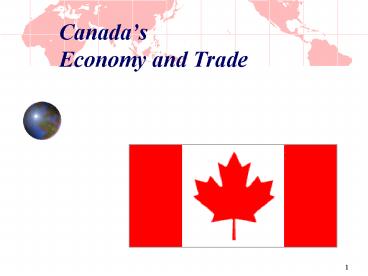Canadas Economy and Trade - PowerPoint PPT Presentation
1 / 32
Title:
Canadas Economy and Trade
Description:
Among G-7 countries, the ratio of Canada's exports of goods and services as ... Canada relies on foreign markets to sustain growth and high income. ... – PowerPoint PPT presentation
Number of Views:386
Avg rating:3.0/5.0
Title: Canadas Economy and Trade
1
CanadasEconomy and Trade
2
Outline
- Basic facts about Canada
- Commercial policy (history)
- NAFTA
- Recent trade data (1988-2001)
- Trade theory
3
A primer on Canada
- Colors
- Red, White, and (thats it!)
- Symbols
- Maple Leaf, Beaver
- Coins
- Loonie, Toonie
- Anthem
- O Canada!
- Sport
- Land of Hockey
4
(No Transcript)
5
A better primer on Canada
- Area 10 million sq. km (6.2 million sq. miles).
2nd largest. - Population 30 million
- Government
- Representative, parliamentary democracy.
- Confederation of 12 provinces (each with
Parliament) - Legislative ? Executive (Cabinet from
Majority/Plurality Party) - Prime Minister (provincialgovernor,
federalpresident) - Languages English French
- Federal jurisdictions
- Trade, commerce, defense, telecoms, immigration,
navigation shipping, fisheries, banking
currency, criminal law, civil rights freedoms,
etc. - Provincial jurisdictions
6
Population Density, 1996
7
First Language English (1996)
8
First Language French (1996)
9
Comparison to United States
- 1/10th size of population GDP.
- Income per-capita lower but higher human
development index (U.N.) - Trade is relatively more important.
- Size Role of Government
- Education, Health Care, Unemployment Insurance,
Social Security, Transfers. - More government ? more taxes.
- Provinces are somewhat like States.
10
Canadas Exports and Importsof Goods and
Services as percentage of GDP
11
Among G-7 countries, the ratio of Canadas
exports of goods and services as percent of GDP
in 2000 was the highest.
45.3
11.1
33.3
11.2
30.1
33.4
29.2
12
History of Commercial Policy
- 1840-1914
- Search for partners
- Nationalism on the rise
- Pragmatic protectionism
- 1914-1945
- (British) Preferential system (trade blocks)
- Post-1945
- Towards regional free-trade
13
In the beginning
- 1867 Birth of Canada (BNAA).
- Article 121 prohibits inter-provincial barriers,
and gives federal government authority to impose
tariffs. - Tries to exercise its powers of taxation and
import duties, but it must contend with Britain,
up until end of WWII.
14
Canadian Economy
- Initially sustained by natural resources, now
also manufacturing and services. - Diversified by region
- Manufacturing ? Quebec, Ontario
- Fishing ? Maritimes
- Wheat, Coal, ? Prairies
- Forest, Mining ? B.C.
- Provinces must be consulted on trade policy, and
interests differ.
15
An ambiguous relationship
- Ups and downs of protectionist sentiment
(Conservatives vs. Liberals). - Compromise between satisfying trading partner and
securing access to foreign markets. - GATT/WTO have allowed (somewhat) market
diversification, but regional trade is a magnet
(limits of policy).
16
Fear and Opportunity
- Canada relies on foreign markets to sustain
growth and high income. This goes towards
openness and free-trade. - It fears relying too much on a single partner
(Britain then, U.S. today). Cultural and economic
nationalism goes towards (partial)
protectionism. - Reality is that regional economic integration
occurs despite periods of protectionism on both
sides and attempts at diversification.
17
Towards regional FTA
- Reciprocity Treaties
- 1854-66
- Many failed attempts (e.g. Laurier 1911)
- 1935
- 1965 Auto Pact.
- 1970s-80s Nationalism, Protectionism.
- 1989 U.S.- Canada FTA.
- 1994 NAFTA ( Mexico).
18
Levels of economic integration
- Free-Trade Agreement
- Establishes unimpeded exchange of goods and
services between trading partners regardless of
national borders (e.g. NAFTA). - Customs Union
- FTA Common external policy (e.g. Mercosur).
- Common Market
- Customs Union Labor mobility Policy
coordination (e.g. EU).
19
NAFTA Highlights
- Established in 1994.
- 360 million consumers.
- Combined GDP of 6 trillion.
- Progressive (over 5-10 years) elimination of
tariffs and NTBs. - Principle of national treatment
(non-discrimination). - Limited access to public procurements.
- Partial liberalization of foreign investment.
- Protection for some sectors (agriculture, autos,
energy, textiles, ).
20
Impact on Canada
- Any regional FTA involves
- Trade diversion
- Trade creation
- Diversion seems negligible and creation is
readily observable. - In last 10 years, exports to (and imports from)
U.S. have increased 1.5 fold! - Trefler estimates that ¼ of these increases are
directly attributable to NAFTA.
21
Canadas Trade of Goods and Services
billion
22
Canadas Current Account Balance
Percent
Billion
23
Stock of Foreign Direct Investment in Canada
billion
24
Distribution of US Merchandise Imports
Percent of Total
25
Distribution of US Merchandise Exports
Percent of Total
26
US Merchandise Trade Balance
US Billion
27
Destination of Canadas merchandise exports
28
Origin of Canadas merchandise imports
Geographical groupings as defined by Statistics
Canada.
29
Trade TheoryComparative Advantage
- Canada is relatively land abundant (natural
resources) - ? natural comparative advantage in land
intensive industries. - Accounts for large surplus in energy and forestry
products. - Within agriculture, large net imports of fruits
and vegetables, and large net exports of live
animals. - In industrial sector, large surplus in metals and
ores. - Acquired comparative advantages
(learning-by-doing economies of scale) in some
manufacturing, services, and hi-tech industries. - Anomaly? Large trade in auto products.
- Auto Pact (1965)
- Intra-industry trade (New Trade Theory)
30
Trade in services relative to total tradein
goods and services.
31
Canada-US Exchange rate
32
Geographic distribution of trade
- Over the last year, trade with the United States
has been adversely affected by terrorist attacks
and by the slowdown in economic growth in North
America. - In consequence, Canadas trade has been
reoriented somewhat away from the United States
to the rest of the world. - Overall, trade with the United States still
dominates the picture, averaging C1.85 billion
per day in 2001, down from 1.91 billion in 2000.
This is the largest bilateral trade relationship
in the world!































